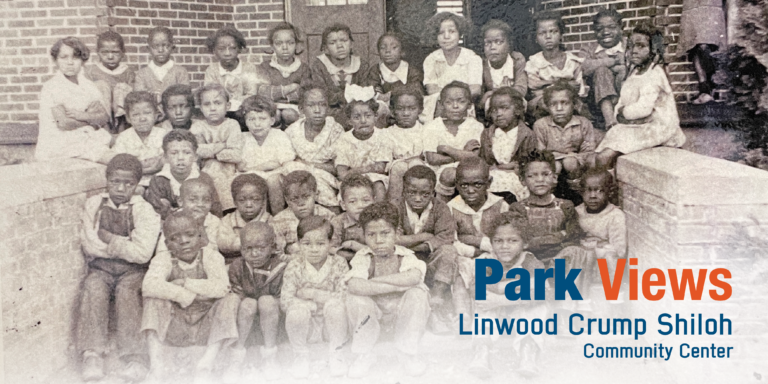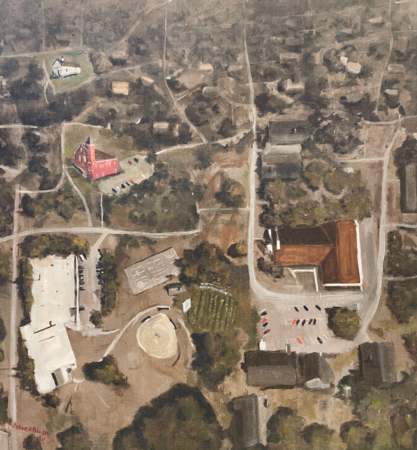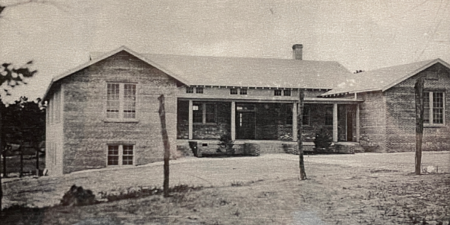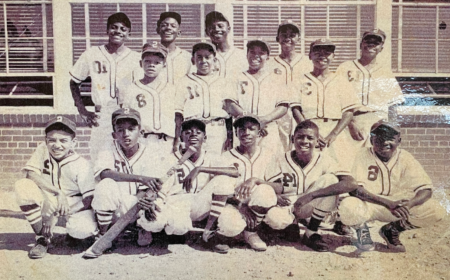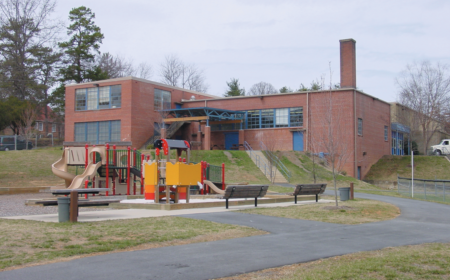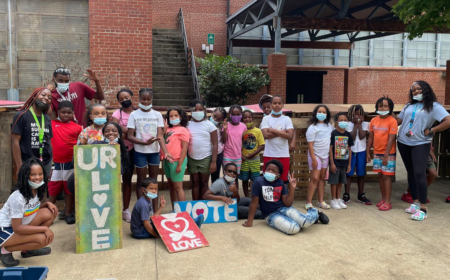This entry is part of Park Views, as Asheville Parks & Recreation series that explores the history of the city’s public parks and community centers – and the mountain spirit that helped make them the unique spaces they are today. Read more from the series and follow APR on Facebook and Instagram for additional photos, upcoming events, and opportunities.
This entry is adapted from educational panels on display at Linwood Crump Shiloh Community Center, a former school for Black children that was converted to public recreation use in the 1970s. Even before its adaptive reuse, it acted as the center of the Shiloh community with theatre productions, meetings, and athletic events taking place within and around the outside of its walls.
Historic Shiloh
After the Civil War, a dozen or so African American freedmen established the original Shiloh community on a small parcel of land in the area of present day Biltmore. These people sold their property to George Vanderbilt and moved to the community’s current location, calling it New Shiloh. In 2011, a marker was added to Biltmore’s grounds to commemorate Old Shiloh Road.
In old Shiloh, the people had a small African Methodist Episcopal (AME) Zion church that was also used as a school. Vanderbilt purchased the church and the acre on which it stood in September 1889 for $1,000. The church burned shortly after and he replaced it with a new one, moving it and the old church graves to New Shiloh. Along with Rock Hill Missionary Baptist Church and Brooklyn Mission Fire Baptized Holiness Church, it acted as a cornerstone from which the community developed. They continue to be an integral part of the spiritual, cultural, and social fabric of the neighborhood.
Early New Shiloh was a rural area with dirt roads and small family farms. The earliest residents lived along West Chapel Road (originally known as Logan Road), White Avenue, Shiloh Road, and Brooklyn Road. Rock Hill and Petersburg, nearby African American neighborhoods, were already established at the time residents from Old Shiloh moved into the new community and today are considered part of Shiloh.
Shiloh’s connection to Biltmore continued after the move with many residents such as Samual Barnes landscaping the grounds or holding positions on its farm. Others worked as midwives, teachers, dentists, business owners, and in a number of other professions.
Rosenwald School
The Rosenwald school building program was funded by philanthropist Julius Rosenwald, president of Sears, Roebuck, and Company. He partnered with African American educator and activist Booker T. Washington, first working with Washington’s Tuskegee Institute and then forming an independent foundation to manage the school program. After meeting in 1912, the two men built thousands of schools for Black students in 15 states. The Rosenwald Schools, as they are known, were often the first schools in a Black community and helped improve education across the South.
More Rosenwald schools were erected in North Carolina than any other state. Shiloh Elementary was one of those schools. It opened as a fire-resistant brick structure with a large front porch. The main level had a library surrounded by six classrooms each with a cloakroom, office, and workroom. The basement had a cafeteria, kitchen, storage area, and restroom.
A Rosenwald school was a source of great pride for the community and getting one was not an easy task. Shiloh residents had to raise money to match the Rosenwald grant. They also had to persuade local whites and the Buncombe County Schools Board of Education that educating Black students was important. Residents had to donate time (sweat equity) and supplies to come together for a common cause. All of this fostered a sense of achievement and community ownership in the school.
Shiloh Elementary School
On several occasions during the early 1920s, Shiloh residents appeared before the Board of Education to petition for a new school. Before submitting an application for Rosenwald aid, the Superintendent of Buncombe County Schools (BCS) had to select a building plan, ensure a suitable site was secured, and determine that Black citizens pledged enough of their own funds.
In 1927, the Board of Education awarded the school construction contract to Lucius Williams, a fireman for Southern Railway who settled in Shiloh in 1913. After his retirement from the railroad, he became a successful contractor and builder of many homes in Shiloh and Asheville. He was an active member of the community and served as a Shiloh School Committeeman for several terms.
Kids in grades 1-8 from Shiloh, Rock Hill, Brooklyn, Arden, Fletcher, and other nearby African American communities attended Shiloh Elementary School where a standard North Carolina curriculum was taught with used textbooks supplied from white schools. Shiloh Elementary alumni recall excellent teachers who supplemented the deficiency in BCS support with other resources. They also incorporated information about Black history, culture, and literature which was not part of the standard state curriculum.
Students participated in a variety of extracurricular activities including girls and boys basketball teams, Scouting, an annual spring maypole festival, and baseball sponsored by the Shiloh Community League. In the segregated society of the time, Black residents relied on the school as their social and cultural center.
Shiloh Elementary School graduated its last class in 1969. After sitting vacant for a decade, the original Rosenwald wing was demolished. A 1952 expansion remains as part of the current community center.
Shiloh Recreation Center
In the late 1960s and early 1970s, most Black schools in the Asheville area closed and African American students enrolled in previously all-white schools. Asheville City Schools sold Burton Street, Livingston Street, and Stephens-Lee schools to the City of Asheville to use as Asheville Parks & Recreation (APR) community centers. Following their success, APR proposed leasing Shiloh Elementary from BCS and renovating the building and grounds.
Initial plans in 1977 included a ballfield, tennis courts, playground, and more parking outside. The old school building would be remodeled into a two level facility with a gymnasium, classrooms, game room, offices, and an all-purpose room with a stage and kitchen.
Utilizing $623,000 in federal community development funds, Shiloh Recreation Center was officially dedicated in 1980. APR operated recreation programs for all ages in the center and leased space to other nonprofit organizations focused on health and wellness.
After leasing for many years, the City of Asheville purchased the property for $250,000 in 1997. APR set about making significant upgrades following the transaction and a new playground and walking trail opened in 2000.
Linwood Crump Shiloh Community Center
By declaration of Asheville City Council, the center was renamed Linwood Crump Shiloh Recreation Center in 2006 to honor a strong community activist and advocate for the children of Shiloh. Over the years, Crump coached neighborhood football, basketball, and baseball teams. Affectionately known as the “Mayor of Shiloh,” he was an outspoken voice for the community and never shied away from taking community issues to City Hall.
Crump lived for more than 50 years in Shiloh where he absorbed the love of friends and family that he returned as he worked to improve his community through youth programs, fighting commercial encroachment, and other efforts. He earned the respect of a wide range of community leaders with Mayor Terry Bellamy saying at his funeral, “Every neighborhood in the city of Asheville needs a Linwood.”
In 2022, APR completed a major renovation that updated much of the outdoor space with a new playground, outdoor fitness equipment, repaved walking trail, new basketball court, improved ballfield drainage, and more. The indoor gym and fitness center were also renovated and solar panels added to the building’s roof.
Though the original Rosenwald building no longer exists, the spirit of Shiloh’s founders and all who came after them lives on in the neighborhood with Linwood Crump Shiloh Community Center serving as an integral part of the community’s cultural and social fabric.
For more on Shiloh and Black roots in Asheville, read the Asheville African American Heritage Resource Survey.
Do you have photos or stories to share about Linwood Crump Shiloh Community Center? Please send them to cbubenik@ashevillenc.gov so APR can be inspired by the past as we plan our future.
Photo and Image Credits
- Shiloh Elementary School students pose for a photo outside of the school circa 1933.
- Shiloh, A Visual History by artist Joseph A. Pearson hangs in the community center’s multipurpose room. The painting addresses five major landmarks of the Shiloh community. The large white building on the left is Linwood Crump Shiloh Community Center. Shiloh Community Garden can be seen in the center of the lower part of the painting. The building with a brown rooftop is Rock Hill Missionary Baptist Church, Shiloh AME Zion Church is the red building in the center, and Brooklyn Mission Church is the small white building in the upper left.
- The original Rosenwald wing of the school. Courtesy of Fisk University Archives.
- 1958 baseball team sponsored by Shiloh Community League.
- A new playground and walking track debuted in 2000.
- When schools and churches temporarily transitioned to virtual during the COVID-19 pandemic, Linwood Crump Shiloh Community Center became an important hub for students, older adults dependent on prepared meals, and a space to stay healthy while distancing. Community members even made affirmation signs to place throughout the neighborhood.
